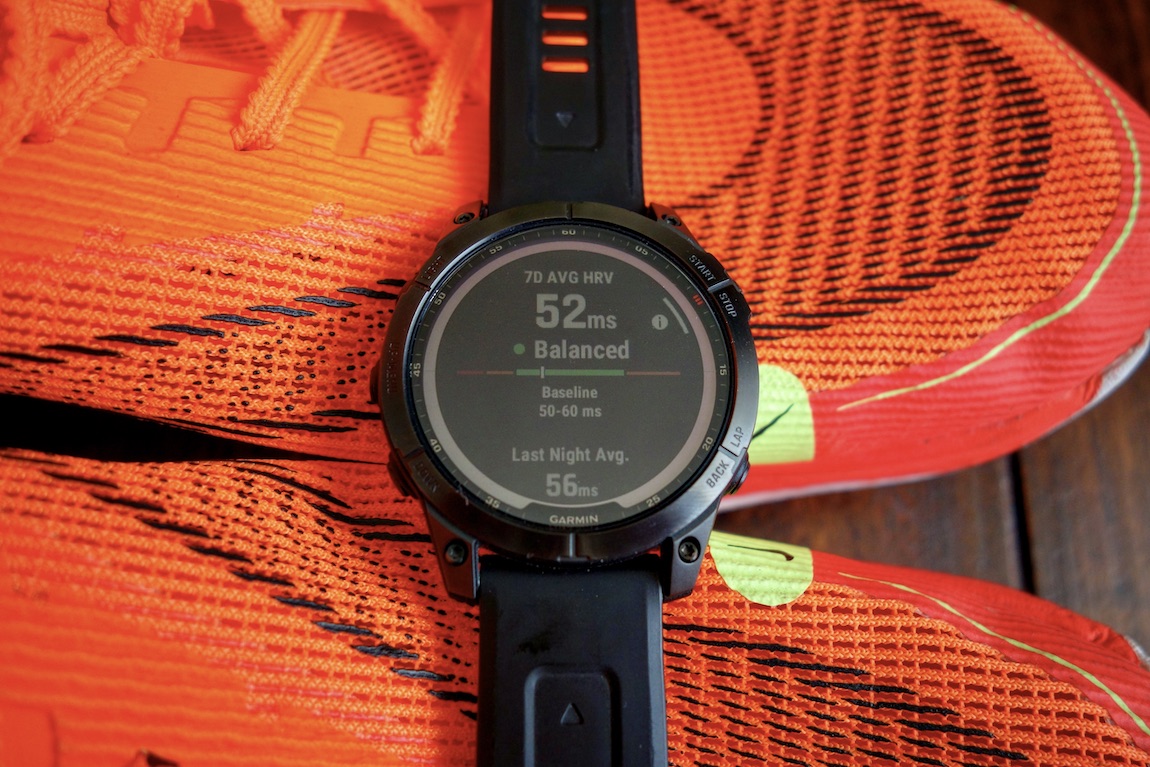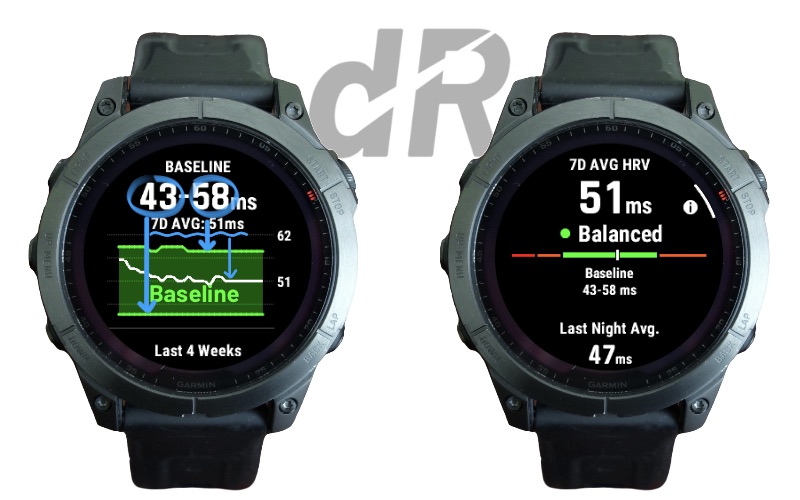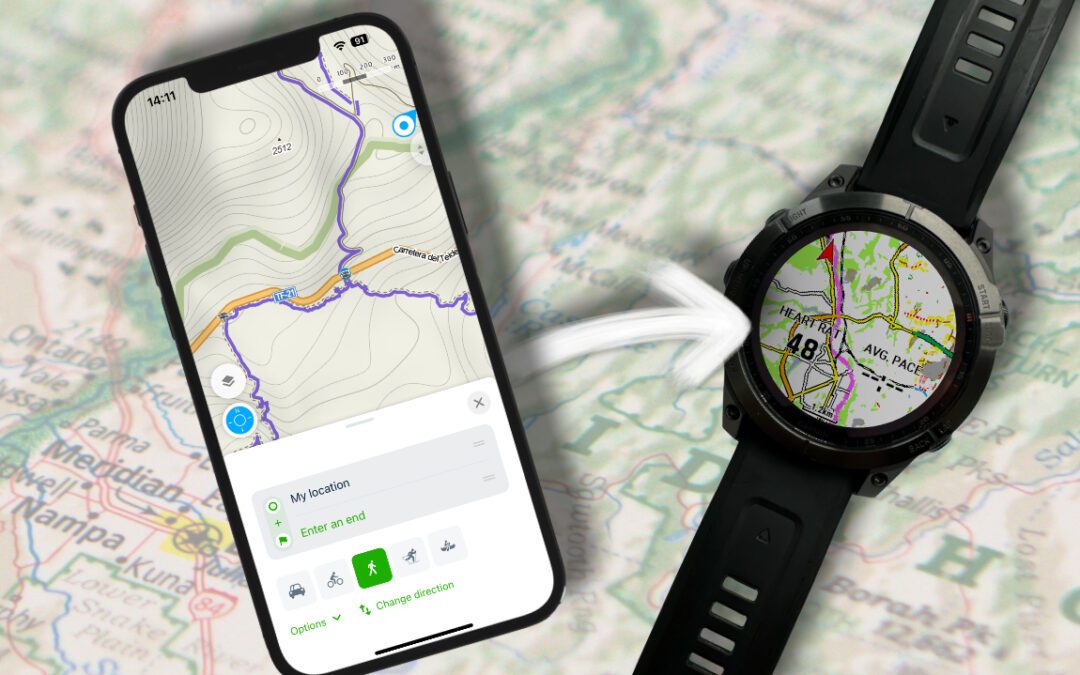Chapter 6 of the Ultimate Guide to Running With Your Garmin Watch | Series Overview >
TABLE OF CONTENTS
6.1. HRV Status
6.2. Resting Heart Rate (RHR)
6.3. Stress
6.1. HRV Status
HRV Status provides valuable insights into how your body responds to physical and mental stress based on your heart rate variability. After the first three weeks, you will get a personalized HRV Baseline, a range of your typical overnight HRV values. The widget will also give you an HRV Status, which is a 7-day Average of your HRV values expressed in milliseconds. Based on where your 7-day Average falls compared to your Baseline, you’ll get a Balanced (within your Baseline) or Unbalanced/Low (outside of your Baseline) HRV Status.
Generally, if you see a stable or increasing 7-day Average of your HRV, it is a sign that your body is adapting and recovering well from the stress of training. On the other hand, if your average HRV value is trending down, it could indicate that you’re pushing too hard in your training or that you’re affected by other life stressors, such as lack of sleep, work stress, inadequate fuelling, early signs of illness, etc. As you may have guessed already, proper contextualization of this metric is key in order to get an accurate picture of your overall health and well-being.
The Overnight Average HRV value is also helpful, as it indicates how your body handles the most recent stress induced by your training and other life stressors. For example, if you wake up in the morning and your Overnight Avg HRV is low (nearing the bottom of the Baseline or even falling below it), this could indicate that you might need an easy recovery day or even complete rest to prepare for harder training. Conversely, if you wake up in the morning and your Overnight Avg HRV is high (in the middle or at the top of your Baseline), this could indicate that you’re recovering well and are ready to hit a harder session.
In summary, the Overnight Average HRV is a building block of the 7-day Average Value that determines your HRV Status, so the metrics are very much interrelated. However, the HRV Status tracks long-term trends in your heart rate variability, while the Overnight Average HRV is a snapshot of your heart rate variability from last night.
Limitations
Your HRV is like the spokesperson for your autonomic nervous system, which regulates things like your heartbeat, breathing, digestion, etc. This means that HRV does not have to reflect how sore you feel (think your musculoskeletal system). So although your HRV may indicate that you are ready to fire, if you feel like hot garbage after a hard run or strength training session, respect it and rest until you feel ready again. Never blindly follow a metric. Always reflect how you feel overall.
6.2. Resting Heart Rate (RHR)
Resting heart rate refers to the number of heartbeats per minute (bpm) when a person is at complete rest. Your resting heart rate can serve you as:
- Fitness Progress Indicator: A sign of positive training adaptations is a decreasing resting heart rate trend which indicates a more efficient heart and better overall cardiovascular fitness. In my experience, my resting heart rate went from the low 50s to the low 40s over the course of months of consistent training.
The picture shows my body’s positive response to training after a two-month training break. For the untrained, the decreasing trend will be much more incremental. However, if you train consistently, you can expect positive adaptations to continue for months and even years.
- Training Guide: The 7-day Average of your resting heart rate can be a helpful guide about how your body is handling current training. If your heart rate stays at or below your weekly average, it can indicate that your body is taking the current training load well. Contrary, if your resting heart rate goes above, it can indicate that your body is under increased stress from the recent load. Based on that, you may want to include an easy recovery day or adjust your training load if this trend continues.
- Indicator of Overtraining: A sudden and significant increase in resting heart rate that persists over time, especially when accompanied by other symptoms like fatigue, poor sleep, decreased performance, lack of motivation, rhinitis, etc., could indicate overtraining or other underlying health issues.
Getting The Most Out of Your RHR and HRV in Training
You can look at your resting heart rate as a magnifying glass that gives you a macro perspective of your heart and autonomic nervous system. To dive even deeper, you can further use your heart rate variability (HRV) metrics, which give you insights on a micro level.
What I like to do in the morning is first to check my Resting Heart Rate to get an overarching idea of how things are looking and then look at my Overnight Average HRV to get even more granular. Sometimes my resting heart rate can be identical for a few days, but the HRV will fluctuate, giving me greater insight and a deeper understanding of my body’s response. By keeping an eye on both metrics, I can make more informed decisions regarding my training, recovery, and other lifestyle choices.
6.3. Stress
Garmin uses heart rate variability to determine stress levels. The stress level is expressed as a value from 0 to 100, with 100 indicating the highest level of stress. It is important to note that this metric looks at stress in a comprehensive way. It takes into account physiological stressors such as training, high ambient temperature, potential impending incipient illness, etc., as well as psychological stress caused by various challenging life situations. For this reason, it is critical to properly contextualize the numbers you are looking at, as failing to do so may lead to misinterpretation.
So how can this metric serve you to optimize your training?
Let me give you a few examples:
- Illness Detector: Garmin’s Stress feature can help you become more aware of changes in your body that could indicate the onset of an illness. For example, if your stress levels are higher at rest compared to your normal levels, it may be a sign that your body is fighting an infection or incipient illness. In practice, this could involve checking your stress level during the day, especially before a workout. If you notice significantly elevated stress levels compared to your normal values, adjusting your training or taking a day off might be beneficial.
- Recovery Insight Provider: Your stress levels can give you insights into how well your body is recovering after workouts. If your stress levels remain high for too long after a training session, it could be an indication that your body hasn’t fully recovered and needs more rest. By monitoring your stress levels, you can optimize your training schedule, ensuring you have adequate recovery time between sessions.
- Fitness Indicator: Over time, as you improve your fitness, you should see a decrease in your average stress levels. This is because a well-conditioned body can handle stress more effectively and recover from it more quickly. Also, decreasing stress levels in response to your typical workout routine can be a good indication that your fitness is improving.
Click here to go back to Chapter 5
Click here to go back to Chapter 7












![Best Garmin Fenix 7 Watch Faces [2024]](https://dialedrunner.com/wp-content/uploads/2023/11/Best-Garmin-Fenix-7-Watch-Faces-for-Different-Occasions-1080x675.jpg)

![How To Import Gpx Course To Garmin Connect on iPhone [2024]](https://dialedrunner.com/wp-content/uploads/2023/09/How-To-Import-Gpx-Course-To-Garmin-Connect-iPhone_Header-1080x675.jpg)
0 Comments